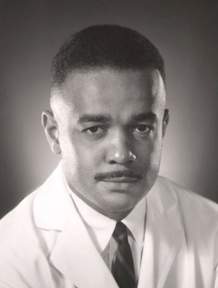By Ben Beito
John C. Norman, Jr. was an outstanding surgeon, medical writer, and medical educator who graduated Phi Beta Kappa from Harvard and made many contributions to cardiac surgery. Born on May 11, 1930 in Charleston, West Virginia, his father, who shared his name, was a prominent architect and structural engineer. His mother, Ruth Stephenson Norman, was a long-time high school English teacher in Charleston.
Norman was an intellectually gifted individual from the very beginning as he graduated as Valedictorian of Garnet High School in his hometown at age sixteen. He initially entered Howard University but soon after transferred to Harvard. From there he graduated Magna cum Laude and Phi Beta Kappa in 1950. After going on to earn his M.D. degree from Harvard Medical School, he served in the U.S. Navy from 1957-1958 aboard the USS Saratoga as the ship’s surgeon. After this, Norman became an intern and resident doctor at Presbyterian Medical Center and Bellevue Hospital in New York. He then completed his official surgical training at the University of Michigan Ann Arbor.
Taking to the academics of medicine along with his practice, Norman served on the surgical staff of Boston City Hospital and, simultaneously, as an associate professor of surgery at Harvard Medical School. While in Boston, he accomplished revolutionary procedures including a spleen transplant from a healthy Beagle to one with hemophilia. The research surrounding this procedure suggested that spleen transplants from healthy to hemophiliac humans could increase natural production of a substance that lessens symptoms of hemophilia.
In 1972, Norman left Boston to establish the Cardio Surgical Research Lab at the Texas Heart institute. There, he performed implantations of a pneumatic abdominal left ventricular assist device called the Model-7 ALVAD. The device was used to preserve the lives of patients whose hearts had failed after cardiac surgery and subsequently awaited a heart transplant. Logically, it was an important stepping-stone in the development of more sophisticated heart pumps.
Also while at the Texas Heart Institute, Norman researched possible energy sources and materials for artificial hearts. He performed a specific experiment, described in Science News magazine, Volume 94 under the heading “Other Things at Heart,” involving the implantation of a small nuclear fuel cell into the aortic region of a dog. The results were favorable, as the fuel cell only slightly increased the dog’s blood temperature and the heat could be harnessed to power a tiny steam engine to drive an artificial heart implant.
As a culmination of his numerous contributions to medicine, which include and aren’t limited to 14 medical texts and over 700 articles on his research and clinical practices, Norman received the Congressional Award for Science and Technology in 1985. He was an honored member of the Society of Black Academic Surgeons. The organization’s homepage proudly features an inspirational statement from Norman:
“Our heritage is richer for some of the courses set by others. What we wish to do with this marvelous legacy remains to be seen. The challenge and opportunity are here.”
Norman lived out his final days in Bedford Massachusetts where he passed away on August 23, 2014.
Ben Beito is a senior at St. Olaf College majoring in Architectural Studies, a program he designed himself. St. Olaf College is home to the Delta of Minnesota Chapter of Phi Beta Kappa.




